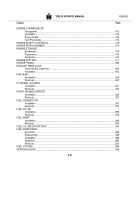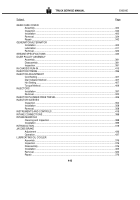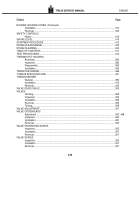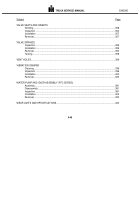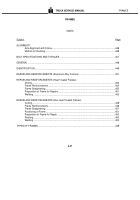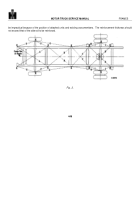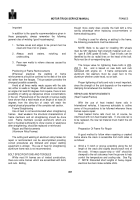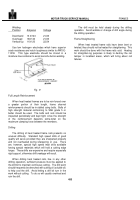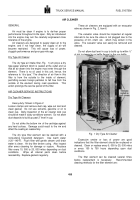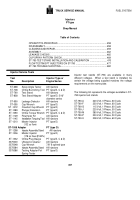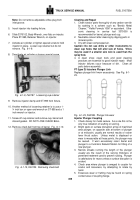TM-5-3805-254-14-P-2 - Page 455 of 894
MOTOR TRUCK SERVICE MANUAL
FRAMES
Important
In addition to the specific recommendations given in
these paragraphs, always remember the following
general rules of welding “good housekeeping”.
1.
Surface areas and edges to be joined must be
clean and free of oil or grease.
2.
Always
avoid
craters,
notching,
and
undercutting.
3.
Peen new welds to relieve stresses caused by
shrinkage.
Positioning of Frame Reinforcements
Whenever
practical,
the
welding
of
frame
reinforcements should be confined to the web of the side
rail rather than the flanges.
This procedure provides the
strongest possible assembly.
Avoid at all times welds made square with the side
rail, either on webs or flanges.
When welds are made at
an angle of at least 30 degrees from square, there is less
possibility of setting up dangerous stress concentrations
in the rail.
Physical tests of the strength of various welds
have shown that a weld made at an angle of at least 30
degrees from the direc-tion of strain will retain the
original physical properties of the complete rail section.
Frame Straightening
Use of heat is not recommended when straightening
frames.
Heat weakens the structural characteristics of
frame members and all straightening should be done
cold.
Frame members (except aluminum) which are
bent or buckled sufficiently to show cracks or weakness
after straightening, should be replaced or reinforced.
Repair and Reinforcements
(Aluminum Alloy Frames)
The cutting and welding of aluminum alloy frames for
repair or reinforcement can be accomplished providing
correct procedures are followed and proper welding
equipment is utilized.
The use of heat for straightening
aluminum frame rails is not recommended.
BOLT SPECIFICATIONS AND TORQUES
While most IH frames are of riveted construction,
there are some frames which are assembled with bolts
and nuts.
Bolting,
though more costly does provide the field with a time
saving advantage when replacing cross-members or
frame attaching parts.
If bolting is used for altering or adding to the frame,
the following precautions must be observed.
NOTE: Bolts to be used for installing fifth wheels
must be 5/8” diameter high strength material such as I.
H.
type 8 (SAE grade 8) bolts.
Type 8 bolts can be
identified by the six radial lines on the head of the bolt.
Nuts must be of corresponding type.
The torque value for tightening these bolts is 220-
250 ft.
lbs.
and is based on new bolts and nuts
lubricated with engine oil.
If frame components are
aluminum, flat washers must be used next to the
aluminum whether under head, nut or both.
Proper tightening of bolts and nuts is most important,
since the strength of the joint depends on the maximum
clamping force between the members.
REPAIR AND REINFORCEMENTS
(Heat Treated Frames)
With the use of heat treated frame rails in
International vehicles, it becomes advisable to outline
some of the procedures to be followed whenever these
frames require repair.
Heat treated frame rails must not, of course, be
intermixed with non-heat treated rails.
If one side rail is
to be replaced, the new rail material must match the old
frame rail.
Preparation Of Frame For Repair
A good method to follow when repairing a cracked
frame where the crack is accessible from both sides is
as follows:
a.
Grind a V notch or groove extending along the full
length of the crack and slightly beyond each end of
the crack.
A heavy copper strip or “chill” should be
clamped to the rail side away from the groove to help
control the temperature and cooling rate.
See Fig.
7.
NOTE: Discarded short lengths of heavy copper
electrical bus bars make suitable chills.
451
Back to Top

